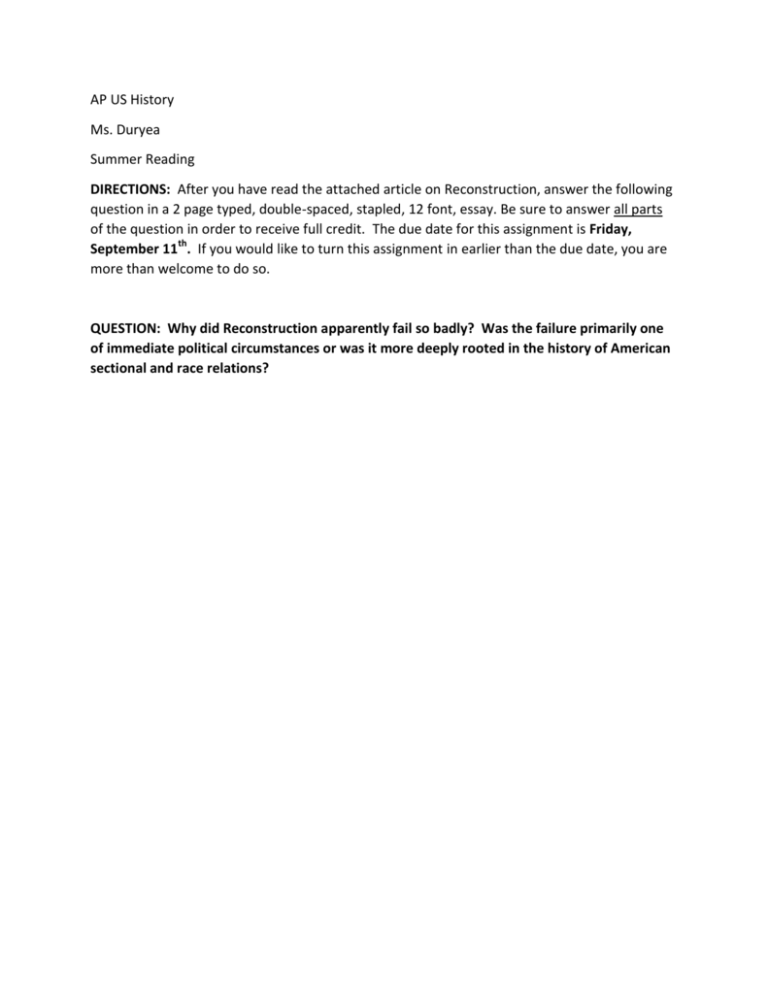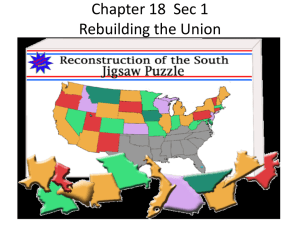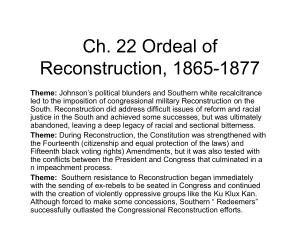us history ii ap honors - Lenape Valley Regional High School
advertisement

AP US History Ms. Duryea Summer Reading DIRECTIONS: After you have read the attached article on Reconstruction, answer the following question in a 2 page typed, double-spaced, stapled, 12 font, essay. Be sure to answer all parts of the question in order to receive full credit. The due date for this assignment is Friday, September 11th. If you would like to turn this assignment in earlier than the due date, you are more than welcome to do so. QUESTION: Why did Reconstruction apparently fail so badly? Was the failure primarily one of immediate political circumstances or was it more deeply rooted in the history of American sectional and race relations? Reconstruction in the South, 1864 – 1877 by Dan Mowbry Even before the United States military beat the Confederate rebels, the nation faced daunting tasks. The Civil War had killed and hurt over a million people and the survivors were not happy about the losses. There were severe economic dislocations in the southern United States. Slavery was ended and would be gone before the last shot was fired. The United States contended that the Confederacy was an illegal government as were the state governments of the Confederacy, that those who defied the Unite States were simply traitors who had rebelled. This constitutional issue—the status of the rebellious state—had no easy solution. There was no satisfactory way to solve these problems; too many people wanted different outcomes. The death toll from the Civil War was at least over 600,000. Several times this number were maimed. The casualty toll was well over a million. Civilian deaths and injuries also occurred but we do not know precisely how many. Several million casualties out of national population of 31,443,321 was horrendous. No war before or since fought by the United States wreaked such human damage. And most of them were in the southern part of the United States, in the Confederacy, where the war was fought with a few exceptions. A major reason why white Southerners were so bitter after the war (besides the fact that they had lost) had to be their acute awareness of the price of war. Beloved husbands, brothers, fathers, sons, uncles and grandfathers were dead and missing because of the war. Others were blinded or deafened or missing a limb or two. One of the largest state government expenses in Mississippi after the Civil War was for prosthetic devices. Injuries are a constant reminder. The social order had changed. Slaver no longer existed. Instead, there were 4,500,000 free blacks, over 286,000 of whom were in the United States Army. Armed African Americans alarmed many whites. In Mississippi and South Carolina, blacks were the majority. In other Southern states they were a sizable minority. In 1865, what would be the place of blacks in the new social order was uncertain but most whites in the United States assumed that they would do what they had done before the war—working as farm laborers in the rural areas. Social change was not just a matter of accommodating of free blacks but also of the social dislocations created by the war. Fortunes had been lost and some made. In the great American tradition, people migrated to the South in search of economic gain. Some had come to know the region while serving in the U.S. Army. The women who had operated the family property while their men folk were fighting were not as docile as they were before the war. Even those who managed to retain their property and prestige faced the fact that the labor system they knew and enjoyed was gone and new arrangements had to be made. Idle farm lands had to become productive again. The physical destruction from the war was sizable. Bridges were destroyed, railroad tracks ripped up, buildings burned or damaged, factories gone, work horses and mules killed or injured and other physical assets destroyed or gone. Although things could be rebuilt or replaced, it took time, once investment capital could be found. Confederate money was virtually worthless and with it, investment capital almost disappeared. Since most adult white Americans(1) thought in purely political terms—who could vote and who could run for office—they did not see the socio-economic aspects of reconstruction the South—nation building in 21st century parlance. As they looked at the Constitution for answers, they saw no easy answer for the writers of the Constitution had never anticipated secession. Were the states which claimed they seceded actually of the United States—the Union—or were they simply in a state of rebellion? If the former, did that mean the Congressional power to regulate territories and admit new states came into play? If the latter, did the President’s power to pardon and his power as commander in chief of the military become decisive? A literal interpretation of the Constitution provided no answers but neither did a broad interpretation. The decision would be political depending upon who held the most of the power. The Reconstruction process began before the end of the war. President Abraham Lincoln used the enormous powers he had taken during the war to implement a reconstruction plan. It was simply political. When 10% of the 1860 electorate gave an oath of loyalty to the United States and recognized the end of slavery, they could elect state government officials and men to the national House of Representatives and Senate. Before the end of 1864, Virginia, Tennessee, Arkansas and Louisiana had met these terms but Congress refused to seat the people they elected. Lincoln and Congress were going to fight about reconstruction but then he was murdered by a Southerner. Another Southerner, Andrew Johnson, became president. He would also fight with Congress. There were two Reconstructions—Presidential and Congressional—but both were complicated by the people who were affected. The defeated Southern whites looked to the victors to tell them what to do but they had limits to what they were willing to tolerate. They wanted as little change as possible and, at first, elected the very people who had led them into this disastrous war. Those leaders were the only ones they knew. Black southerners wanted real freedom including the right to own property vote, hold public office, education and move at will. Strong, educated leaders quickly emerged among black southerners. The victors did not agree on what should be done. Some wanted the South punished because it had caused the death and injury of so many. Most wanted the United States preserved. Easily, most whites believed in the inferiority of blacks and Native Americans and that bigotry influenced attitudes and, therefore, behavior, Democrats had opposed the war and emancipation. They received 45% of the presidential vote in 1864 so their views counted. The Republican Party split over Reconstruction with a powerful minority wanting to insure that the newly freed slaves and other blacks had the means of staying free. They were the group who gave Lincoln and Johnson hell. Presidential Reconstruction was conciliatory in nature. They wanted to get the country united again as soon as possible. Lincoln had to pocket veto the Wade-Davis Bill (July, 1864) which demanded that a majority of white Southerners of a state swear allegiance to the United States before they could hold a convention to create a new state government. In addition, Congress was not so forgiving of those who had led the fight against the United States. Confederate leaders, state government officials and those who had volunteered to fight the United States of America would be ineligible to attend the state conventions, vote or elected to office. Although Lincoln vetoed this measure which was so punitive, he did allow as how it was one of the several possibilities. Andrew Johnson worked under severe disadvantages when he succeeded Lincoln. He was a Southerner, which made him suspect among many, even though he had remained loyal to the United States even at personal risk. He was a poor man from mountainous east Tennessee whose wife taught him to read and write. He had little affection for the upper class. Perhaps because his life had been so hard, much harder than that of Lincoln, he lacked Lincoln’s political acumen. He was also a man without a political party. He had left the Democratic Party to run with Lincoln on the Constitutional Union ticket. He was not a Republican either. Johnson proposed amnesty for all those who would swear allegiance to the United States except important Confederate officials and those persons who owned more than $20,000 of property(2). No doubt Johnson intended to exclude his old adversaries, which these requirements would do. Those who took the oath would elect a constitutional convention which would repudiate secession and slavery as well as the Confederate national and state debts. Once that was accomplished, they could elect a state government and send representation to Washington. By the end of 1865, each former Confederate state had been through either the Lincoln or Johnson plan. Conservatives assumed that Reconstruction was over. People were getting back to work. Governments did their jobs. The pre-Civil War order had been largely restored. That was a problem, for it appeared that the former Confederate states had learned nothing. Although slavery had been abolished, they tried to keep African Americans as close to slavery as possible. “Black Codes,” laws which only applied to blacks, were passed. In some states, the law restricted the right of blacks to meet. In some states, the labor of petty offenders could be sold at public auction, clearly legalized slavery. Some states allowed whites to take children from their parents and apprentice them without their parent’s permission(3). States often required that blacks, but not white or Native Americans, have labor contracts. South Carolina said blacks could only be domestic servants or farm laborers, fewer occupations than they pursued doing slavery! Not surprisingly, there were race riots in 1865-1866. Blacks and those who supported them almost always lost. Johnson grew stubborn. He blamed the race riots on the “Radical Republicans,” those Republicans like Thaddeus Stevens and Charles Sumner who were trying to insure that the former slaves had real freedom. President Johnson minimized the denial of black rights and began pardoning thousands of Southern whites. In the 1866 Congressional elections, he campaigned around the country, calling his opponents traitors. He was bucking national sentiment. In November, 1866, the Republicans won two-thirds of both Houses. “Radical Republicans” moved into positions of leadership. Congress decided to use force and occupation to reform the South believing that conciliation had not worked. Congress reacted. It passed a Civil Rights bill in April, 1866 over Johnson’s veto and new Freedmen Bureau law in July, 1866. It proposed the Fourteenth Amendment which said, in part: All persons born or naturalized in the United States, and subject to the jurisdiction thereof, are citizens of the United States and of the State wherein they reside. No State shall make or enforce any law which shall abridge the privileges or immunities of citizens of the United States; nor shall any State deprive any person of life, liberty, or property, without due process of law; nor deny to any person within its jurisdiction the equal protection of the laws. The amendment provided for other important measures to punish Confederate leaders and states which denied its adult males the right to vote. Only Tennessee ratified it. Some state legislatures rejected it unanimously. The Freedmen’s Bureau bill passed over Johnson’s veto signifying that the former slaves were to be protected by the national government during the transition, an unprecedented expansion of federal government power for it meant that the national government assumed care of individuals for the first time . Congress passed the Civil Rights bill over Johnson’s veto. In March, 1867, it passed the First Reconstruction Act which divided the South into 5 military districts headed by a major general. All adult males, including freed slaves, would be able to vote in state elections. When a state ratified the 14th Amendment and guaranteed adult male suffrage, it would be readmitted to the Union. Johnson’s veto was overridden the same day. With the passage of the 15th Amendment in February, 1869 which said that “The right of citizens of the United States to vote shall not be denied or abridged by the United States or by any State on account of race, color, or previous condition of servitude.” Johnson and most Southern states disliked Congressional Reconstruction(4) but the presence of the U.S. Army and its nation building efforts kept the state in line. Johnson, although emasculated by Congressional actions, still had some power such as the power to pardon and the power to appoint people to national office(5). Fearing that Johnson would remove persons sympathetic to the Congressional program, Congress passed the Tenure of Office Act in March, 1867 over Johnson’s veto. It said that the President could not remove any person whose appointment required the consent of the Senate and could only suspend such an appointee when the Senate was out of session. In the summer of 1867, Johnson ordered the resignation of Secretary of War Edwin Stanton, a Lincoln appointee who sided with Congressional leaders and appointed General Ulysses S. Grant in his place. Stanton refused to budge. When the Senate reconvened in January, 1868, it voted 35 to 16 to keep Stanton. Johnson believed the Act was unconstitutional and insisted that his appointee, now another army general, take the post(6). In February, the House of Representatives impeached Johnson for violating the Tenure of Office Act and other “high crimes and misdemeanors” by a vote of 126 to 47. Clearly, it was a partisan political act. Johnson was acquitted by one vote but he was now ineffective until Grant became president on March 4, 1869. Reconstruction proceeded apace in the South. Arkansas, North Carolina, South Carolina, Louisiana, Georgia, Alabama and Florida were readmitted under the Military Reconstruction Act by June 1868. Many of these states had a combination of blacks, white Southerners and immigrants from other parts of the nation running Reconstruction governments. Only in Louisiana and South Carolina did blacks constitute a majority in the state legislature. Texas, Mississippi and Virginia were readmitted by 1870(7). Reconstruction in Mississippi is a representative example of how Reconstruction operated in practice for it was not at either extreme. Southern whites, for the most part, did not want change, especially freedmen participating in politics. Violence got bad enough that Congress passed an Enforcement Act in 1870 to punish those who tried to deprive the freedmen of their civil rights. By 1872, however, Congress passed a general amnesty law, pardoning all but 500 Confederate sympathizers. Congress passed the Civil Rights Act of 1875 which said that all persons had to be treated equally in the use of public transportation facilities, in hotels and inns, and in theaters but the law was not always enforced. Former Confederate states slowly elected white Democrats to office. By 1876, only Florida, Louisiana and South Carolina retained Republican Party governments. That Congressional Reconstruction governments created public school systems, repaired bridges and other infrastructure, helped the poor relief and passed universal adult male suffrage laws was beside the point. Conservatives often did not want these things and resented the taxes that were levied to pay for them. The fact that blacks were involved was enough to anger them. The old order had been overturned. They worked to restore as much of the status quo antebellum as they could. To many Southern whites, therefore, life before the War was idyllic. Of course, the antebellum South they longed for never existed except that black people had no power. The economic devastation and dislocations of the Civil War made it impossible to restore the economy of the South to what it was in 1860. There was precious little capital in the region. Land owners needed money to buy seed and tools, to pay laborers and to live on until they could harvest a crop and sell it. Farm workers, black and white, needed employment and they were the vast majority of Southerners. Farm owners could mortgage their future crop (the crop lien system) in order to plant, till and eat. The money loaned very often came ultimately, from other parts of the nation, funneled through local banks or general stores. To enhance the possibility of being repaid, lenders usually insisted that the farmers plant cash crops. Cotton and tobacco were the usual cash crops. If a local general store loaned the money, often extending a line of credit to the farmer, it insisted that the farmer buy everything through the store even when the item might be cheaper elsewhere. Bad harvests or low prices or both meant the farmer fell further and further into debt. Sharecropping grew as farmers hired workers by letting them either share in the harvest or giving them access to some of the farmer’s land. The sharecropper also thus got the right to buy on credit at the local store. Sharecropping increased in the South beyond the rest of the 19 th century. It was a kind of economic slavery and affected whites and blacks alike. In the 1880’s, Henry Grady of Atlanta and some other Southern leaders launched a drive to bring more industry to the South. Birmingham, Alabama became a steel center. With government subsidies, direct and indirect, numerous factories were started, especially in the lumber, tobacco and textile industries. Parts of the South saw the rise of mill towns. The nation as a whole was industrializing. However, the percentage of national industry in the South did not change between 1860 and 1900. Until the New Deal and World War II, the South remained poor and agrarian. The Democrats finally gained power in Louisiana, Florida and South Carolina when the Republican Party made a deal to get their man. Rutherford B. Hayes, an honest and able ex-Civil War general from Ohio where he had attended Kenyon College, thus making him one of the better educated people in the country, elected to the Presidency. To win by one electoral vote, the Republican Party backed by the federal government which it controlled had to get 15 Republican electors instead of Democratic electors elected. They challenged the results in South Carolina, Florida and Louisiana on the grounds that African American voters had been intimidated by whites (which was probably true), thus denying the Republican victory. Those state governments were still controlled by the Republicans. If they pulled this off they still needed another electoral vote, which they found in Oregon where a Democratic elector could be disqualified because he was a U.S. government employee, a postmaster. To settle the dispute, Congress agreed to create a bipartisan Electoral Commission of 15 men evenly split between the two parties and with the 15th member to be a non-partisan judge. Not long before the Commission was to meet, the judge resigned to take a federal job and the Republicans were able to get one of their own appointed. All decisions were made by that partisan 8 to 7 margin. But the Democrats controlled the House of Representatives and did not have to accept the results so the Compromise of 1877 was made by which federal troops would be withdrawn from the South thus allowing the bigots to resume full control and the South would get federal favors including the building of a Southern transcontinental railroad. Conservatives of both parties had joined to prevent a possible civil war. The abandonment of protection off all citizens continued. In the 1883 Civil Rights Cases, the U.S. Supreme Court ruled that the Civil Rights Act of 1875 was unconstitutional because, it said, the 14th Amendment did not prohibit individuals from discriminating on the basis of race and state laws which were discriminatory were simply instances of individual discrimination. The logic was twisted but was consistent with the views of most people. In Plessy v. Ferguson in 1896, a case brought first in Louisiana by Homer Plessy who had been denied the right to sit where he wished on a streetcar, the Supreme Court ruled that separate facilities were permissible as long as they were equal. Although some blacks continued to serve in some Southern legislatures into the early years of the 20th century, these cases meant the end of the last vestiges of Reconstruction. One should not be surprised. United States citizens in the 19 th century believed that the best government was that which governed least. They did not like state governments which did much of anything. In the South, that’s a major reason why the conservative white supremacist politicians gained power from the Republicans. They promised to cut government spending and did by passing the costs to the local levels. They saw national government action as even worse than state government action. Americans believed that there were natural laws which governed human affairs and, thus, governments should do almost nothing. White Americans, regardless of locale, had little desire to aid black Americans. The reform zeal had died. People wanted to go about their business and to focus on the industrial boom which was occurring. Like all nation building efforts, Reconstruction of the South required prolonged military occupation and cooperation by the defeated. That is what occurred in post-WWII Germany and Japan, nation building exercises much more severe and thorough than anything that occurred in the South between 1865 and 1877. But the United States was a different country in 1945 than it was during Reconstruction. The irony is that Americans see Reconstruction as a horrible episode in U.S. history, which it was not, and the Civil War, which was, as heroic. Much of this came about as an effort to reconcile the South to being in the United States by allowing it to win the battle of historical interpretation 1. Women, Native Americans and most African Americans could not vote when Reconstruction began. 2. Since the average working man only earned about $200 per year, $20,000 worth of property meant one was rich. 3. Kidnapping and slavery are other terms to use for the effects of this law. 4. The period when Congress was doing Reconstruction is called both Congressional Reconstruction and Radical Reconstruction. The author prefers Congressional Reconstruction because Congress would remain the dominant branch of government for the rest of the century. 5. There was no civil service and appointing people to office was an important political tool in those days. 6. The issue was not resolved until 1926 when the Supreme Court, in the case of Myers vs. United States, ruled the law unconstitutional. 7. For a perspective on Reconstruction, a black man who freed himself before the Civil War, see Frederick Douglass, “Reconstruction,” Atlantic Monthly 18 (1866): 761-765.









